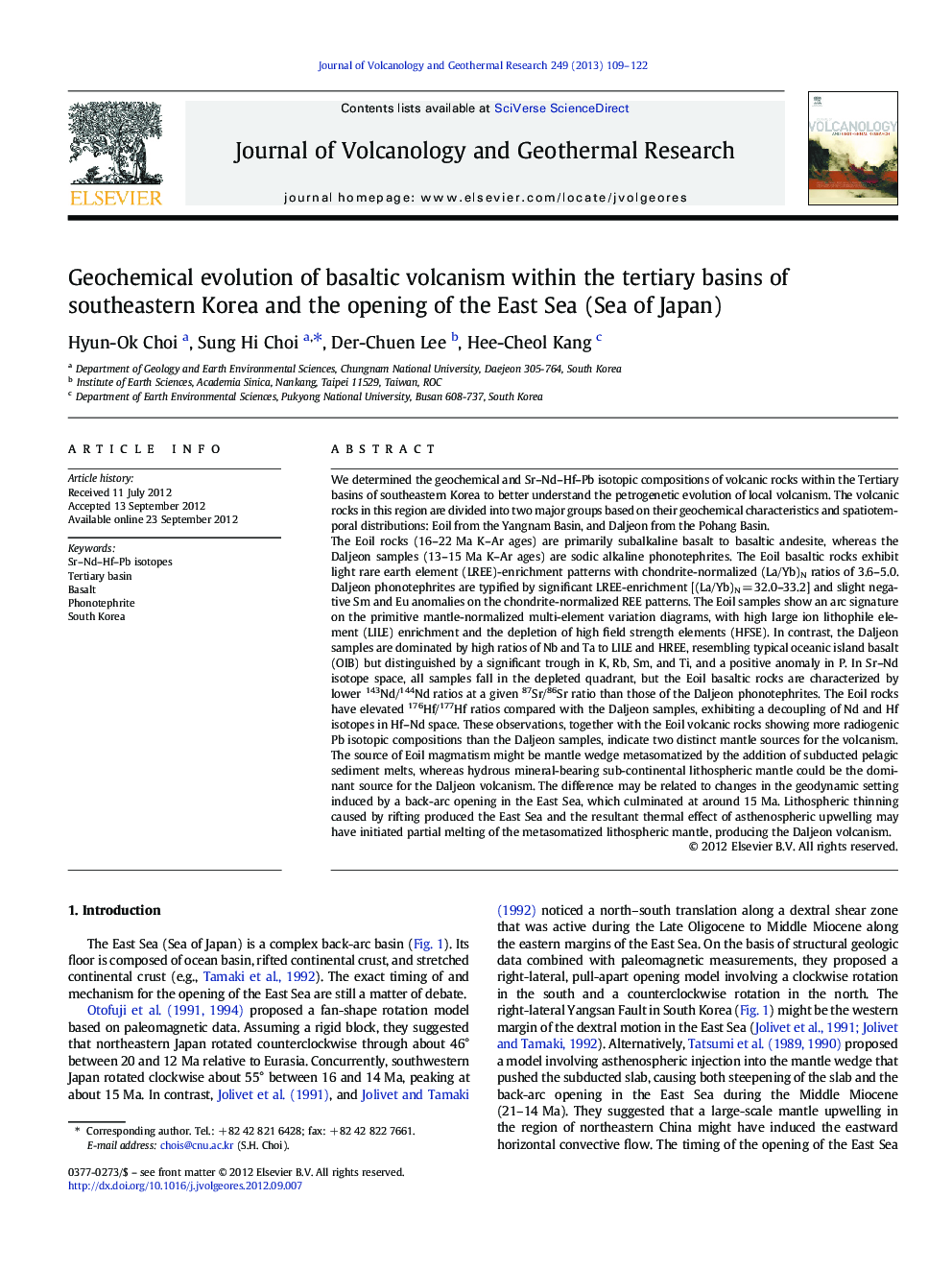| کد مقاله | کد نشریه | سال انتشار | مقاله انگلیسی | نسخه تمام متن |
|---|---|---|---|---|
| 4713586 | 1638372 | 2013 | 14 صفحه PDF | دانلود رایگان |
We determined the geochemical and Sr–Nd–Hf–Pb isotopic compositions of volcanic rocks within the Tertiary basins of southeastern Korea to better understand the petrogenetic evolution of local volcanism. The volcanic rocks in this region are divided into two major groups based on their geochemical characteristics and spatiotemporal distributions: Eoil from the Yangnam Basin, and Daljeon from the Pohang Basin.The Eoil rocks (16–22 Ma K–Ar ages) are primarily subalkaline basalt to basaltic andesite, whereas the Daljeon samples (13–15 Ma K–Ar ages) are sodic alkaline phonotephrites. The Eoil basaltic rocks exhibit light rare earth element (LREE)-enrichment patterns with chondrite-normalized (La/Yb)N ratios of 3.6–5.0. Daljeon phonotephrites are typified by significant LREE-enrichment [(La/Yb)N = 32.0–33.2] and slight negative Sm and Eu anomalies on the chondrite-normalized REE patterns. The Eoil samples show an arc signature on the primitive mantle-normalized multi-element variation diagrams, with high large ion lithophile element (LILE) enrichment and the depletion of high field strength elements (HFSE). In contrast, the Daljeon samples are dominated by high ratios of Nb and Ta to LILE and HREE, resembling typical oceanic island basalt (OIB) but distinguished by a significant trough in K, Rb, Sm, and Ti, and a positive anomaly in P. In Sr–Nd isotope space, all samples fall in the depleted quadrant, but the Eoil basaltic rocks are characterized by lower 143Nd/144Nd ratios at a given 87Sr/86Sr ratio than those of the Daljeon phonotephrites. The Eoil rocks have elevated 176Hf/177Hf ratios compared with the Daljeon samples, exhibiting a decoupling of Nd and Hf isotopes in Hf–Nd space. These observations, together with the Eoil volcanic rocks showing more radiogenic Pb isotopic compositions than the Daljeon samples, indicate two distinct mantle sources for the volcanism. The source of Eoil magmatism might be mantle wedge metasomatized by the addition of subducted pelagic sediment melts, whereas hydrous mineral-bearing sub-continental lithospheric mantle could be the dominant source for the Daljeon volcanism. The difference may be related to changes in the geodynamic setting induced by a back-arc opening in the East Sea, which culminated at around 15 Ma. Lithospheric thinning caused by rifting produced the East Sea and the resultant thermal effect of asthenospheric upwelling may have initiated partial melting of the metasomatized lithospheric mantle, producing the Daljeon volcanism.
► Sr–Nd–Hf–Pb isotopes for volcanic rocks from the Tertiary Basins of S. Korea
► Evolution from arc-related Eoil rocks to enriched SCLM-sourced Daljeon phonotephrites
► Eoil basaltic rocks showing a decoupling of Nd and Hf isotopes in Hf–Nd space
► Opening of the Sea of Japan might induce the evolution from Eoil to Daljeon volcanism
Journal: Journal of Volcanology and Geothermal Research - Volume 249, 1 January 2013, Pages 109–122
